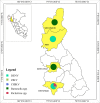Unidentified dengue serotypes in DENV positive samples and detection of other pathogens responsible for an acute febrile illness outbreak 2016 in Cajamarca, Peru
- PMID: 33023645
- PMCID: PMC7541171
- DOI: 10.1186/s13104-020-05318-5
Unidentified dengue serotypes in DENV positive samples and detection of other pathogens responsible for an acute febrile illness outbreak 2016 in Cajamarca, Peru
Abstract
Objective: To describe the prevalence of dengue virus serotypes, as well as other viral and bacterial pathogens that cause acute febrile illness during an outbreak in Cajamarca in 2016.
Results: Dengue virus (DENV) was the most frequent etiologic agent detected in 25.8% of samples (32/124), followed by Rickettsia spp. in 8.1% (10/124), Zika virus in 4.8% (6/124), Chikungunya virus 2.4% (3/124) and Bartonella bacilliformis 1.6% (2/124) cases. No positive cases were detected of Oropouche virus and Leptospira spp. DENV serotypes identification was only achieved in 23% of the total positive for DENV, two samples for DENV-2 and four samples for DENV-4. During the 2016 outbreak in Cajamarca-Peru, it was observed that in a large percentage of positive samples for DENV, the infecting serotype could not be determined by conventional detection assays. This represents a problem for the national surveillance system and for public health due to its epidemiological and clinical implications. Other viral and bacterial pathogens responsible for acute febrile syndrome were less frequently identified.
Keywords: Arbovirus; Chikungunya; Dengue; PCR; Peru; Zika.
Conflict of interest statement
On behalf of all authors, the corresponding author states that there are no conflicts of interest or funding related to this study
Figures
Similar articles
-
Co-circulation and simultaneous co-infection of dengue, chikungunya, and zika viruses in patients with febrile syndrome at the Colombian-Venezuelan border.BMC Infect Dis. 2018 Jan 30;18(1):61. doi: 10.1186/s12879-018-2976-1. BMC Infect Dis. 2018. PMID: 29382300 Free PMC article.
-
Epidemiological, virological and clinical characterization of a Dengue/Zika outbreak in the Caribbean region of Costa Rica 2017-2018.Front Cell Infect Microbiol. 2024 Jun 26;14:1421744. doi: 10.3389/fcimb.2024.1421744. eCollection 2024. Front Cell Infect Microbiol. 2024. PMID: 38988809 Free PMC article.
-
Molecular detection and clinical characteristics of Bartonella bacilliformis, Leptospira spp., and Rickettsia spp. in the Southeastern Peruvian Amazon basin.BMC Infect Dis. 2018 Dec 4;18(1):618. doi: 10.1186/s12879-018-3541-7. BMC Infect Dis. 2018. PMID: 30514235 Free PMC article.
-
Zika Virus Emergence and Expansion: Lessons Learned from Dengue and Chikungunya May Not Provide All the Answers.Am J Trop Med Hyg. 2016 Jul 6;95(1):15-8. doi: 10.4269/ajtmh.15-0866. Epub 2016 Feb 22. Am J Trop Med Hyg. 2016. PMID: 26903610 Free PMC article. Review.
-
The Dengue virus in Nepal: gaps in diagnosis and surveillance.Ann Clin Microbiol Antimicrob. 2018 Jul 16;17(1):32. doi: 10.1186/s12941-018-0284-7. Ann Clin Microbiol Antimicrob. 2018. PMID: 30008269 Free PMC article. Review.
Cited by
-
The Chikungunya virus: A reemerging cause of acute febrile illness in the high jungle of northern Peru.PLoS Negl Trop Dis. 2023 Dec 11;17(12):e0011787. doi: 10.1371/journal.pntd.0011787. eCollection 2023 Dec. PLoS Negl Trop Dis. 2023. PMID: 38079402 Free PMC article.
-
Rickettsia asembonensis Isolated from Four Human Cases with Acute Undifferentiated Febrile Illness in Peru.Pathogens. 2024 Jun 8;13(6):489. doi: 10.3390/pathogens13060489. Pathogens. 2024. PMID: 38921787 Free PMC article.
-
Oropouche virus infection in patients with acute febrile syndrome: Is a predictive model based solely on signs and symptoms useful?PLoS One. 2022 Jul 26;17(7):e0270294. doi: 10.1371/journal.pone.0270294. eCollection 2022. PLoS One. 2022. PMID: 35881626 Free PMC article.
-
Prevalence of dengue in febrile patients in Peru: A systematic review and meta-analysis.PLoS One. 2025 Jun 17;20(6):e0310163. doi: 10.1371/journal.pone.0310163. eCollection 2025. PLoS One. 2025. PMID: 40526741 Free PMC article.
-
Genotypic diversity and molecular characterization of DENV-2 in a Peruvian endemic region from 2016 to 2022: displacement of American/Asian genotype.Front Microbiol. 2025 Apr 28;16:1558761. doi: 10.3389/fmicb.2025.1558761. eCollection 2025. Front Microbiol. 2025. PMID: 40356643 Free PMC article.
References
MeSH terms
Grants and funding
LinkOut - more resources
Full Text Sources
Medical
Miscellaneous


